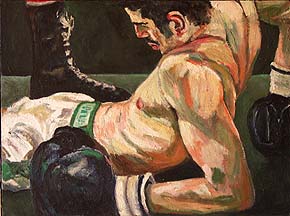Sagadahoc Stories 139: 9/28/05
PostArtum
| When Carlo Pittore died in July we all lost a special friend. At his memorial celebration in September we were reminded of his vast personal influence when people got up for four hours to declare their love of Carlo, and to testify about his caring for them. We were all lucky to know him, and to be touched by his spirit. |
| During the last year we had a chance to say our goodbyes, and to see exhibitions of Carlo’s work, at five shows hosted by different galleries. If we had forgotten, these shows reminded us of what Carlo the painter had been doing all these years, in addition to being our favorite mench. |
| Among the works exhibited there was some stunning new impasto technique on display, and a subtle new treatment of colors. But the paintings Carlo chose to hang were generally of a piece with his work we’d come to know over the years – in style and subject. I had spent a lot of time with Carlo’s works in progress, and I’d photographed and manipulated a lot of images of his paintings. I thought I knew them well. |
It came as a surprise to me, then, to discover my perception of Carlo’s paintings has changed after his death. I always pooh-poohed the revaluation of an artist’s work after their demise, and assumed it was a commercial thing: scarcity equals value. To find out that paintings which left me cold six months ago now grip me is startling. . |
| And fascinating. You wouldn’t think that the artist’s presence or absence would radically alter our perception of his work. But that’s what seems to have happened for me |
|
I had sorted Carlo’s work into categories. His mail art was about giving, and sharing, and political action -- ink sketches and stamps -- heartfelt smoozing and polemical bombast. A vivid and hilarious correspondence. His charcoal and graphite and ink caricatures were telling sketches of the people in his life. His rare landscapes were painterly asides. Carlo’s colored drawings and watercolors were sensitive portraits of those who modeled for him. His drawings in our group modeling sessions were studies for his oils. His oil paintings were Carlo’s magnum opus. |
I thought his mail art was fun. His sketches of people were superb reportage. We treasure the unfinished Pittore landscape we have, of the Bowdoinham Town Hall. I love Carlo’s quick colored portraits, their gift of catching character and expression with a light touch. Those he did of me and Seth are brilliant, and I watched him work the same magic time after time on the Toad. The drawing group studies were technically fascinating. But Carlo’s oil paintings always bothered me. |
| I suspected they were meant to. Sexually (or violently) explicit. In your face. Tortured poses. Very uncomfortable. Not something you’d want to hang in the parlor. They seemed to come out of that fierce and bombastic persona Carlo projected at the art world. He craved attention, recognition, acceptance in the realm of “important” artists, and he never got it. The critics ignored him. The big galleries turned a deaf ear to his harping. He almost never sold any paintings. Carlo’s storage unit at Fort Andross is crammed with his life’s work. And I, too, winced at the loud noise I heard coming off his canvases. |
| One other factor made Carlo’s oils hard for me to look at. I knew most of the models. His totally exposed subjects were our friends and creative companions. A telling portrait is one thing. A revealing portrait of someone sexually in your face, is all too Freudian for my taste – Lucian’s skill notwithstanding. Figure painting is rarely of a person: nudes are abstract subjects. People don’t stand around naked for their portraits. I saw Carlo’s naked oils as strong social statements, about the politics of art, and the state of our cultural attitudes. But I couldn’t see them as paintings. And sometimes the technique seemed as crude as the poses. |
| So I’m shocked to find that those same paintings now speak to me about the human condition. In fact they shout to me. Not about Rachel in a contorted pose with her genitals exposed. About humanity in the abstract, made real by the presence of a clear personality portrayed. Was I too deaf to hear? Or did Carlo stand between me and his work? |
| Because his personality was grandiose, because Carlo was so very present in his studio, or at his shows, because I never saw his paintings as separate from himself – I could never really see them. Maybe that’s true of the art work of all magnified personalities. Or artists we know. |
| The first paintings to reveal themselves to me after Carlo’s passing were of models I didn’t know. I suddenly saw what Carlo – and/or the painting -- was saying. I still was discomforted by the naked portraits of people I know. But the more I look, the less who it is matters. The less Carlo’s relationship with them, or me, intrudes. I can see the paintings just as abstracted statements. And they are full of power. |
| Because he was such a special friend, perhaps we couldn’t see his work apart from him. There was too much personal context to sort out the universal in his art from the particular. |
| This puts a new spin on my craving to explain myself by journalizing about the process. Maybe any power that moves through our work must speak directly to an observer without intermediation. All the subtext can do is ground out the charge. I had always assumed that others would want to know where a piece came from, and how it happened – just as I always found solace and inspiration in the tales of other creative people. Perhaps I’ve been wrong. |
| Maybe all the yammering I did in the gallery this year, telling what
inspired this carving, or how it fit into our personal narrative, only
served to discharge any magic moving from the piece to the observer. Let
the work speak for itself? |
| This is hard news for a compulsive blatherer. And a telling tale about Carlo. Because he had the gift of passionate friendship (or he put people off so thoroughly), perhaps none of us could see past him into his work. Did he make the very recognition he craved impossible to achieve by being too large a personality? |
| Before our artist friend Herb Abrams died he said that his soul would live on in his paintings. Certainly Carlo is very much there in his work, and there is a nostalgic yearning that pulls me when I see his paintings. But it is the soul of the world, the transcendent stuff I never saw before, that enlivens his paintings for me now. |
Because he shook his fists at the world, we couldn’t see how poignant his boxers were in defeat? O Carlo, I’m so sorry I never got to tell you how astonishing I now think your paintings are. |
Next Dispatch |

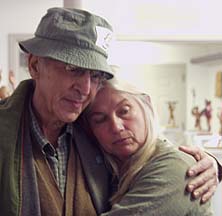
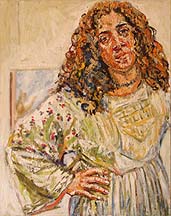
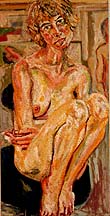
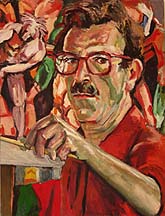
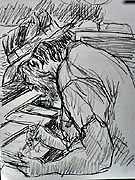
/MailArtz.jpg)
/Sethz.jpg)
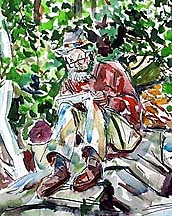
/Brycez.jpg)
/TownHallz.jpg)
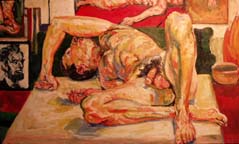

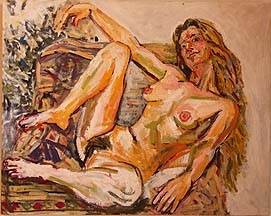
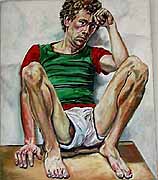
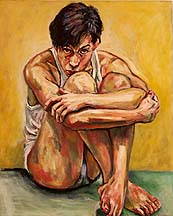
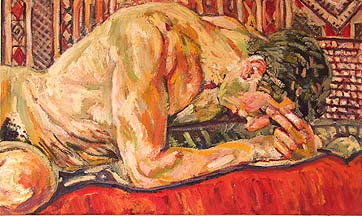
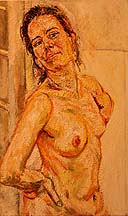 Tell
me
Tell
me 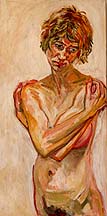

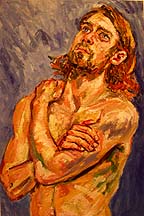 Charisma
Charisma